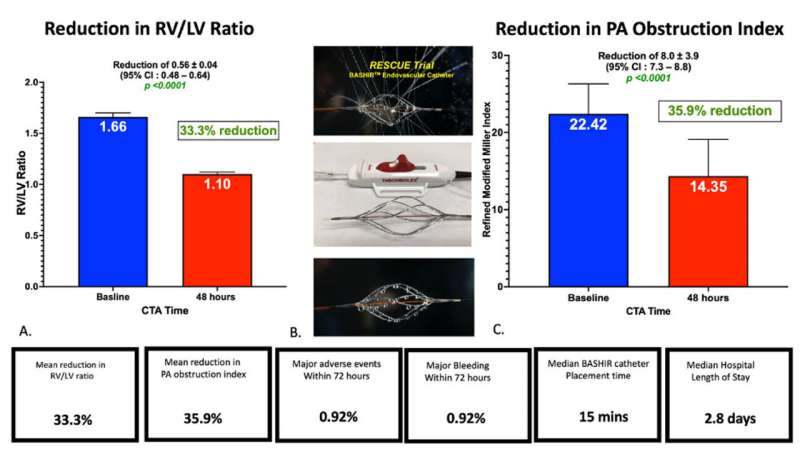Newly developed endovascular catheter shows unprecedented ability to treat pulmonary artery obstruction

A device known as the BASHIR Endovascular Catheter (THROMBOLEX, Inc.) significantly reduces the size of blood clots lodged in the pulmonary arteries, leading to improvement in heart function in patients with pulmonary embolism, researchers from the Lewis Katz School of Medicine at Temple University announced in a Late-Breaking Innovation session at the 2022 Transcatheter Cardiovascular Therapeutics (TCT) conference in Boston. The breakthrough is described in detail in a report simultaneously published online in the JACC: Cardiovascular Interventions.
Evidence for the performance of the catheter comes from data collected in the National Institutes of Health (NIH) sponsored RESCUE trial, a clinical study designed to evaluate the safety and efficacy of the catheter as a novel therapy for pulmonary embolism. The magnitude of reduction in the size of clots obstructing the pulmonary artery in the RESCUE trial was significantly greater than reductions reported for therapies currently used in the treatment of pulmonary embolism.
"For the first time, we are able to show that this treatment not only leads to a remarkable reduction in pulmonary artery obstruction in patients with pulmonary embolism but also is a very safe therapy," said Riyaz Bashir, MD, FACC, Professor of Medicine, Director of Vascular and Endovascular Medicine in the Section of Cardiology Department of Medicine, at the Lewis Katz school of Medicine and Temple University Hospital, and co-inventor of the BASHIR Endovascular Catheter. Temple partnered with the company THROMBOLEX Inc., also a co-inventor, to further the device's development, regulatory pathway, and commercialization.
The BASHIR catheter is made of an expandable basket with mini-infusion catheters. Once placed inside a clot, the infusion basket expands, creating new channels in the clot and thereby increasing the surface area exposed to clot-dissolving drugs delivered through the catheters. The greater exposure area accelerates clot breakdown and the restoration of blood flow through the vessel.
A key clinical feature of the BASHIR catheter is its ability to shorten treatment duration. "With existing devices, treatment by infusion of clot-dissolving drugs can last as long as 10 hours," explained Vladimir Lakhter, DO, Assistant Professor of Medicine at the Lewis Katz School of Medicine and an interventional cardiologist involved in the RESCUE trial. "With the BASHIR device, infusion lasts only five hours. Once the device is removed, we are able to see a dramatic decrease in strain on the heart, bringing significant relief for patients."
"As a site PI for the RESCUE trial, we are proud to be one of the top recruiting sites," said Parth Rali, MD, Associate Professor of Thoracic Medicine and Surgery at the Lewis Katz School of Medicine, Director of the Temple University Health System Pulmonary Embolism Response Team (PERT), and an investigator on the RESCUE trial. "A major reason for this milestone achievement is the multidisciplinary nature of the PERT program and the great benefit that this technology can bring to the population we serve at Temple."
"The RESCUE trial has been an extraordinary journey initiated by discontent with historical outcomes for our patients with pulmonary emboli, fueled by the power of innovation, validated by excellent clinical trial design and execution, and facilitated by a strong collaborative effort here at Temple and with our collaborators across the country," said Daniel Edmundowicz, MD, MS, FACC, Professor of Medicine and Chief of Cardiology at the Lewis Katz School of Medicine and Medical Director of the Temple Heart and Vascular Institute. "Indeed, the RESCUE trial marks a significant therapeutic milestone for patients with pulmonary embolism."
"The results of the RESCUE clinical trial are a momentous achievement in the quest to launch new treatments for pulmonary emboli that are safe and effective," stated Amy J. Goldberg, MD FACS, Interim Dean, Lewis Katz School of Medicine. "It is also a testament to the scientific and clinical research of Dr. Bashir, Dr. Lakhter, and Dr. Rali, their teams, and Temple. I am so proud to have these outstanding leaders a part of our Temple Health family."
The BASHIR catheter was approved by the U.S. Food and Drug Administration (FDA) in 2019 for the treatment of blood clots in veins and arteries in the peripheral vasculature.
More information: Riyaz Bashir et al, Prospective Multicenter Trial of Pharmacomechanical-Catheter-Directed Thrombolysis with the Bashir Endovascular Catheter for Acute Pulmonary Embolism, JACC: Cardiovascular Interventions (2022). DOI: 10.1016/j.jcin.2022.09.011


















